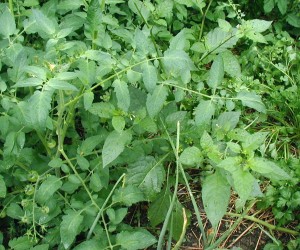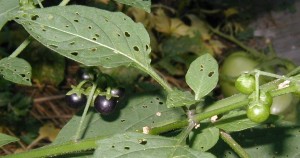We grow the usual garden plants, including a few varieties of tomatoes, hot and sweet peppers, ground cherries, peas, beans, cucumbers, garlic, lettuces, radishes, carrots and many herbs. This year we added into the mix the tomatillo. If it weren’t for the Tomato Family, we would have a garden half as big. The tomatoes, peppers, ground cherries and tomatillos are all members of this family.
We plant seedlings or seeds for many of the vegetables that we want to grow. In addition to planting known veggies, we allow certain ones that re-seed themselves to come up again. Lettuces, cherry tomatoes, and ground cherries are the common re-seeders. The only problem with this method is that the garden can quickly become overgrown if the volunteers are not thinned out vigorously. We learned that last year.
This year a new problem cropped up. A weedy plant was left to grow in the vegetable garden presumably because of its mistaken identity. We’re pretty good at pulling weeds and mulching to keep the weeds from overtaking the garden, but somehow this one weed was left to grow too big.
It turns out that the leaves of this alien plant look a lot like the leaves of the ground cherry. It was hiding under a cherry tomato, and when that was staked up the odd plant was finally noticed. Once detected, it was left to grow a while just for observation. It was pulled out before the fruit was dropped, so hopefully next year we won’t have a garden full.
The alien plant in question was the deadly Common Nightshade, Solanum nigrum. It’s a member of the Tomato family or the Nightshade family, Solanaceae. Other family members include plants that give edible fruits, such as the tomato, potato, ground cherry, bell pepper, chili pepper and eggplant. Tobacco is another useful family member.

Being in the tomato family suggests some similarity between these plants. Common Solanum characteristics include the flower shape with five petals that are often reflexed backwards, yellow stamens that form a beak around the central pistil, and somewhat triangular-shaped leaves.

Tomatoes, ground cherries and tomatillos are similar to the common nightshade. It seemed a little odd that the nightshade leaves were full of holes whereas the others were not. Of course they all had insect damage, but the small roundish holes in the nightshade leaves weren’t seen as much in the other tomato relatives.


Common places to find this nightshade are disturbed areas, waste ground and cultivated grounds, such as found in the vegetable garden. We probably have birds to thank for dropping seeds wherever they go.

DO NOT INGEST NIGHTSHADE BERRIES OR ANY PLANT PART! A chemical called solanine is found in all parts of the plant and it is toxic. See comments below.